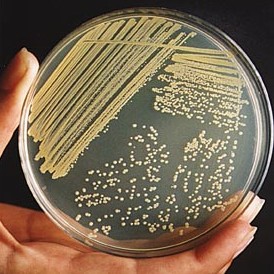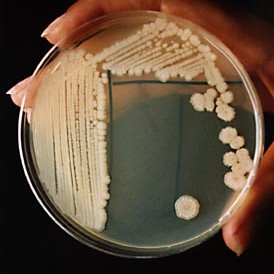Nutrient Agar is a commonly used growth medium in microbiology for the cultivation of a wide variety of non-fastidious micro-organisms. It is very popular in the field of Microbiology because its nutrients support the growth of a variety of bacteria, fungi, and other micro-organisms. In this article, we will explore the composition, preparation, and uses of Nutrient Agar in detail
Table of Contents
Introduction
Nutrient Agar is a growth medium that provides a suitable environment for the growth of bacteria and other microorganisms. It is a solid, jelly-like substance composed of essential nutrients, including peptones, beef extract, yeast extract, and agar. Medium Nutrient Agar was first introduced in the late 19th century by two Danish bacteriologists, Walther Hesse, and Fanny Hesse, and it has since become a cornerstone of microbiological research and analysis
Composition of Nutrient Agar
The composition of Nutrient Agar and Nutrient Broth is the same. The number of ingredients may vary from culture media Manufacturing company. The composition given is a reference to the HiMedia company
| Ingredients | Amount (gm/L) |
| Beef Extract/Yeast extract | 1.5g |
| Peptone | 5g |
| Sodium Chloride | 5g |
| Agar | 15g |
*Final pH of the media: 7.4 ± 0.2
Characteristics of Nutrient Agar/broth Components
The key ingredients in N.A Media includes peptones, beef extract, yeast extract, and agar. Peptones are a source of nitrogen and amino acids, while beef extract and yeast extract provide essential vitamins and minerals. Agar is a polysaccharide derived from seaweed, and it serves as the solidifying agent in Nutrient Agar. The exact composition of N. Agar can vary, with some variations including additional ingredients such as glucose or sucrose for energy
Preparation of Nutrient Agar Media
The preparation of Nutrient Agar culture Medium step by steps-
- Suspend the 28 grams of Nutrient Agar powder in 1000 ml of Purified/distilled water.
- Heat to boiling to dissolve the ingredients completely.
- Sterilize the media by Autoclaving at 15lbs pressure at 121o C for 15 Minutes
- After the sterilization process let it cool to 40-50oC
- Pour Nutrient Agar into each plate (20-25 ml) and leave plates on the sterile surface until the media get solidified.
Factors affecting the quality of Nutrient Agar
Factors affecting the quality of Nutrient Agar include the sterilization method used, the quality of the ingredients, and the temperature and duration of the cooling process. It is essential to follow proper protocols to ensure that the Nutrient Agar is of high quality and free of contaminants
Bacterial colonies on Nutrient Agar Media
The picture credit goes to Science Buddies


Uses of Nutrient Agar
- It is used for the cultivation of less fastidious microorganisms from clinical and non-clinical samples. It can be enriched with blood or other biological fluids.
- Nutrient Agar is widely used in microbiology for the isolation and cultivation of bacteria and other microorganisms
- It is also used to test the growth and metabolic activities of bacteria, including colony morphology and identification
- In addition, Nutrient Agar is used in studies on bacteriology and biochemistry, as it provides a suitable environment for the growth and analysis of microorganisms
Conclusion
In conclusion, Nutrient Agar is a crucial culture media in the study of bacteria and other microorganisms. Its composition, preparation, and uses make it an essential part of microbiological research and analysis. The key ingredients in Nutrient Agar provide the essential nutrients needed for bacterial growth, while the preparation process ensures that the final product is of high quality and free of contaminants. Nutrient Agar will continue to play an important role in the field of microbiology, as researchers seek to better understand the biology of bacteria and other microorganisms researchers seek to better understand the biology of bacteria and other microorganisms.
Reference
- M. Pelczar, E. C. S. Chan, and N. R. Krieg. (2003). “Microbiology: Concepts and Applications”. McGraw Hill
- George M. Garrity, editor-in-chief. (2021). “Bergey’s Manual of Systematic Bacteriology”. Springer.
- D. A. Stahl and H. D. Isenberg. (1989). “Development and evaluation of new agar media for isolation of clinically important bacteria”. Journal of Clinical Microbiology.
- Dana A. Baer, Sarah E. Perdue, and Rachel S. L. Levine. (2018). “Microbiology: An Evolving Science”. W. W. Norton & Company.
Frequently Asked Questions (FAQs)
What is the purpose of Nutrient Agar in microbiology?
The purpose of Nutrient Agar in microbiology is to provide a suitable environment for the growth and reproduction of microorganisms. The agar medium provides a source of essential nutrients, while the agar component of the medium provides a solid surface for the growth of microorganisms
What are the key ingredients in Nutrient Agar?
The key ingredients include peptones, beef extract, yeast extract, Sodium Chloride, and agar
Can Nutrient Agar be used for the growth of all bacteria?
No, Nutrient Agar is not suitable for the growth of all bacteria. Some bacteria may require specific growth conditions, such as increased levels of certain nutrients or a lower or higher pH, that are not provided by Nutrient Agar.
What are the uses of Nutrient Agar in microbiology?
The uses of Nutrient Agar in microbiology include the cultivation and identification of microorganisms, such as bacteria, and the study of their growth and reproduction. It is also commonly used in medical settings for the isolation and identification of pathogenic bacteria
Can Nutrient Agar be used for the isolation of fungi?
Yes, Nutrient Agar can be used for the isolation of fungi. However, some fungi may require specific growth conditions, such as increased levels of certain nutrients, that are not provided by Nutrient Agar.
How does Nutrient Agar compare to other growth media in microbiology?
Nutrient Agar is a commonly used growth medium in microbiology and is often used as a general-purpose medium for the cultivation and identification of microorganisms. It provides a basic source of essential nutrients and is relatively simple to prepare. Other growth media, such as MacConkey Agar or Sabouraud Agar, may be used for the specific cultivation of certain types of microorganisms, but Nutrient Agar is often a good starting point for many microbiological applications
Is Nutrient Agar used in medical settings?
Yes, Nutrient Agar is commonly used in medical settings for the isolation and identification of pathogenic bacteria. It provides a suitable environment for the growth and reproduction of most bacterial pathogens, allowing for their accurate identification and treatment
